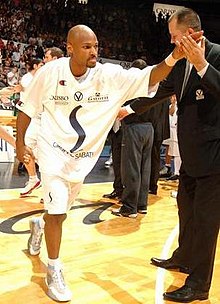Travis Best
 | |
| Personal information | |
|---|---|
| Born | July 12, 1972 Springfield, Massachusetts |
| Nationality | American |
| Listed height | 5 ft 11 in (1.80 m) |
| Listed weight | 182 lb (83 kg) |
| Career information | |
| High school | Springfield Central (Springfield, Massachusetts) |
| College | Georgia Tech (1991–1995) |
| NBA draft | 1995: 1st round, 23rd overall pick |
| Selected by the Indiana Pacers | |
| Playing career | 1995–2009 |
| Position | Point guard |
| Number | 4, 6, 1, 3 |
| Career history | |
| 1995–2002 | Indiana Pacers |
| 2002 | Chicago Bulls |
| 2002–2003 | Miami Heat |
| 2003–2004 | Dallas Mavericks |
| 2004–2005 | New Jersey Nets |
| 2005–2006 | UNICS Kazan |
| 2006–2007 | Virtus Bologna |
| 2007 | Asseco Prokom Gdynia |
| 2007–2008 | Virtus Bologna |
| 2008–2009 | Air Avellino |
| 2009 | NSB Napoli |
| Career highlights and awards | |
| |
| Career NBA statistics | |
| Points | 5,736 (7.6 ppg) |
| Rebounds | 1,249 (1.8 rpg) |
| Assists | 2,444 (3.5 apg) |
| Stats at NBA.com | |
| Stats at Basketball Reference | |
Travis Best (born July 12, 1972) is an American former professional basketball player, who played in the National Basketball Association (NBA) and in Europe.
High school career
Best attended Springfield Central High School, starring on teams that amassed a 69-4 record in his three varsity seasons. He was awarded the Lahovich Award, presented to the top player in Western Massachusetts, after his senior year. Best scored a state-record 81 points in a single game during that season.[1] With then-sophomore teammate Edgar Padilla, a future UMass standout, Best led his 25-0 team to the 1991 Division I state championship and a No. 15 ranking in the final USA Today Top 25. After considering both UConn and the University of Virginia, Best chose Georgia Tech.[2]
Collegiate career
This section of a biography of a living person does not include any references or sources. (May 2010) |
At Georgia Tech, Best teamed with fellow McDonald's All-American James Forrest for four years. The duo lead the Yellow Jackets to the 1993 ACC Tournament Championship, their first since 1990. Best was named to the All-ACC third-team as a sophomore, earning second-team honors as a junior and as a senior. Best led the ACC in assist-to-turnover ratio and free-throw percentage as a senior, while capturing ACC Player of the Week honors a league-record five times.
Best ranked in the top six in Tech history in points, assists, minutes, 3-point field goals made and steals at the conclusion of his collegiate career. He was one of only three ACC players to score 2,000 points with 600 assists (UNC's Phil Ford and Maryland's Greivis Vasquez are the other two). He earned honorable-mention All-America honors from The Associated Press and was a nominee for the Frances Pomeroy Naismith Award, given to the best player in the nation under 6 feet (1.8 m).
Professional career
Best was drafted 23rd in the 1995 NBA draft by the Indiana Pacers.[2] He played for the Pacers, the Chicago Bulls, the Miami Heat, the Dallas Mavericks and the New Jersey Nets, averaging 7.6 points and 3.5 assists per game.
Best was a vital backup at point guard on the 1999-2000 Indiana team that went to the 2000 NBA Finals. Best hit the game-winning 3-pointer in the decisive fifth game against the Milwaukee Bucks in the first round of the playoffs. During the 2001-2002 season, he requested a trade and was granted one to the Chicago Bulls. The Bulls traded Ron Artest, Brad Miller, Ron Mercer and Kevin Ollie to the Pacers for Best, Jalen Rose and Norman Richardson, adding a future second-round pick.
Best had a small role in the 1998 Spike Lee film He Got Game, which also featured NBA players Ray Allen, Walter McCarty, John Wallace, and Rick Fox.
References
- ^ Montville, Leigh (25 March 1991). "Lingering Cheers For A Magic Child". Sports Illustrated. Retrieved 14 June 2011.
- ^ a b Khona, Chetan (1995-11-10). "Best makes pro debut in front of familiar crowd". The Technique. Retrieved 2007-05-22.
External links
- 1972 births
- Living people
- American expatriate basketball people in Italy
- American expatriate basketball people in Poland
- American expatriate basketball people in Russia
- American men's basketball players
- Asseco Gdynia players
- Basketball players from Massachusetts
- BC UNICS players
- Chicago Bulls players
- Dallas Mavericks players
- Georgia Tech Yellow Jackets men's basketball players
- Indiana Pacers draft picks
- Indiana Pacers players
- McDonald's High School All-Americans
- Miami Heat players
- New Jersey Nets players
- Parade High School All-Americans (boys' basketball)
- Point guards
- Sportspeople from Springfield, Massachusetts
